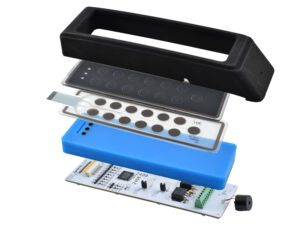It is common to associate touch screens with displays, a lot of our daily interactions with touch screens are that exact combination. Companies manufacturing machines with an HMI tend to disregard touch sensors as a user interface option for this reason, but did you know that you can get touch screen functionality on your device, even if you don’t have a display? These typically come in the form of discrete buttons that are illuminated with backlighting to create a crisp, user-friendly interface.

Many companies are looking to update their design to fit the touch screen style but when a display isn’t needed, there are still options. This can give a modern look and feel to the standard membrane switch keypad.
Display-less touch sensor can be made using screen printed PEDOT, this is a different process than making crystal clear touch screens for use with a display. Many would look at screen printed PEDOT and call it transparent but to our standards, we consider it translucent; the PEDOT gives an ever-so-slightly visible layer to the material which ends up being perfect for backlighting. The touch sensor is then mounted on the decorative glass or acrylic that has the discrete buttons or icons printed directly on it.
With the touch sensor having individual/discrete touch points (rather than full-screen, multi-touch functionality), the actuation sensitivity can be adjusted on the controller to give users the desired feel. More sensitive gives a “touch screen” feel, while less sensitive will require more deliberate pushes from the user, similar to a membrane switch. A regular concern with touch screens in the medical or industrial industries are false touches, this concern can be eliminated electronically with certain controllers and settings!
